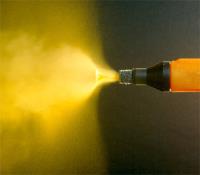 Add My Company
Add My Company
Sign In
Outlining Powder Flow Analysis
06/06/2018

Powder flow analysis is a method for determining the material properties and characteristics of powdered solids in bulk. Bulk powders exhibit vastly different mechanical attributes in dynamic or static states, behaving with mutable characteristics under varying conditions. Compressed, static powders often display similar properties to consolidated materials ? yet when that same substance is subject to motion, it can exhibit fluidic properties. These complex phase transitions are further complicated by the unique mechanical structures of powdered or granulated structures. Molecular density, consistency, and particle morphology can all impact the powder flow characteristics of a bulk material.
Quantifying the powder flow properties of a material necessitates comprehensive analysis of its dynamic and static states. This can enable manufacturers to determine industry-specific parameters such as: caking; flowability; fluidization; granulation; multi-flow; and packing conditions.
Powder Flow Analysis: The Revolution
Powder flow analyzers are used to characterize powder materials and predict their behavior under given mechanical conditions. To ascertain these characteristics, the instrument must be equipped with a mechanical sample drum that can be monitored through high-sensitivity optical measurement components.
The Revolution Powder Analyzer is a leading flowability instrument equipped to perform granulation, caking, and fluidization measurements of powders isolated in a high-purity sample chamber. Test powders are loaded into this internalized drum, which comprises two borosilicate glass panels. A cold cathode backlight provides illumination for the Revolution?s digital camera, and silicone rollers allow the sample chamber to be mechanically rotated. This array allows analysts to collect powder flow imagery at specific speeds. Integrated software analyzes multiple aspects of these images, providing insights into properties such as powder volume and potential energy under pre-defined mechanical conditions.
Flowability is determined by measuring the surface properties of powders that build into peaks or continuously avalanche while the sample drum rotates, with a direct correlation between potential energy and flow capacity.
Granulation and caking, or agglomeration of solid particles, is determined by cross-comparing a powder?s flow properties under varying test conditions. Sustained velocity of contained powders can cause small solid particles to form larger particles, affecting the flow properties of the sample.
Fluidization analysis requires the addition of a gas injection into the sample chamber, to separate the powder particles and encourage a pseudo-liquid phase. The requisite gas pressure to fluidize a powder sample is correlative to its flow properties. Extremely fine powders, for example, may be fluidized purely by increasing the pressure in the sample chamber through rotation.
Applications of Powder Flow Analysis
Powder flow analysis using the Revolution analyzer has routinely been applied for characterizing materials in numerous sectors, including:
Catalysis;
Food research;
Epoxy characterization;
Cosmetics manufacturing;
Powder Flow Analysis with Meritics
Meritics is a leading supplier of test and measurement equipment for materials characterization and particle analysis. We supply a substantial range of instruments for the performance of powder flow analysis, including the Revolution Powder Analyzer.
The Revolution enables researchers to observe and measure powders in sample sizes of 50 cc or 100 cc, with rotational test speeds from 0.1 to 200 RPM.
If you would like any more information about performing powder flow analysis with Meritics equipment, please do not hesitate to contact us.
For more information on Outlining Powder Flow Analysis talk to Meritics Ltd
Enquire Now
More News
List your company on FindTheNeedle.

